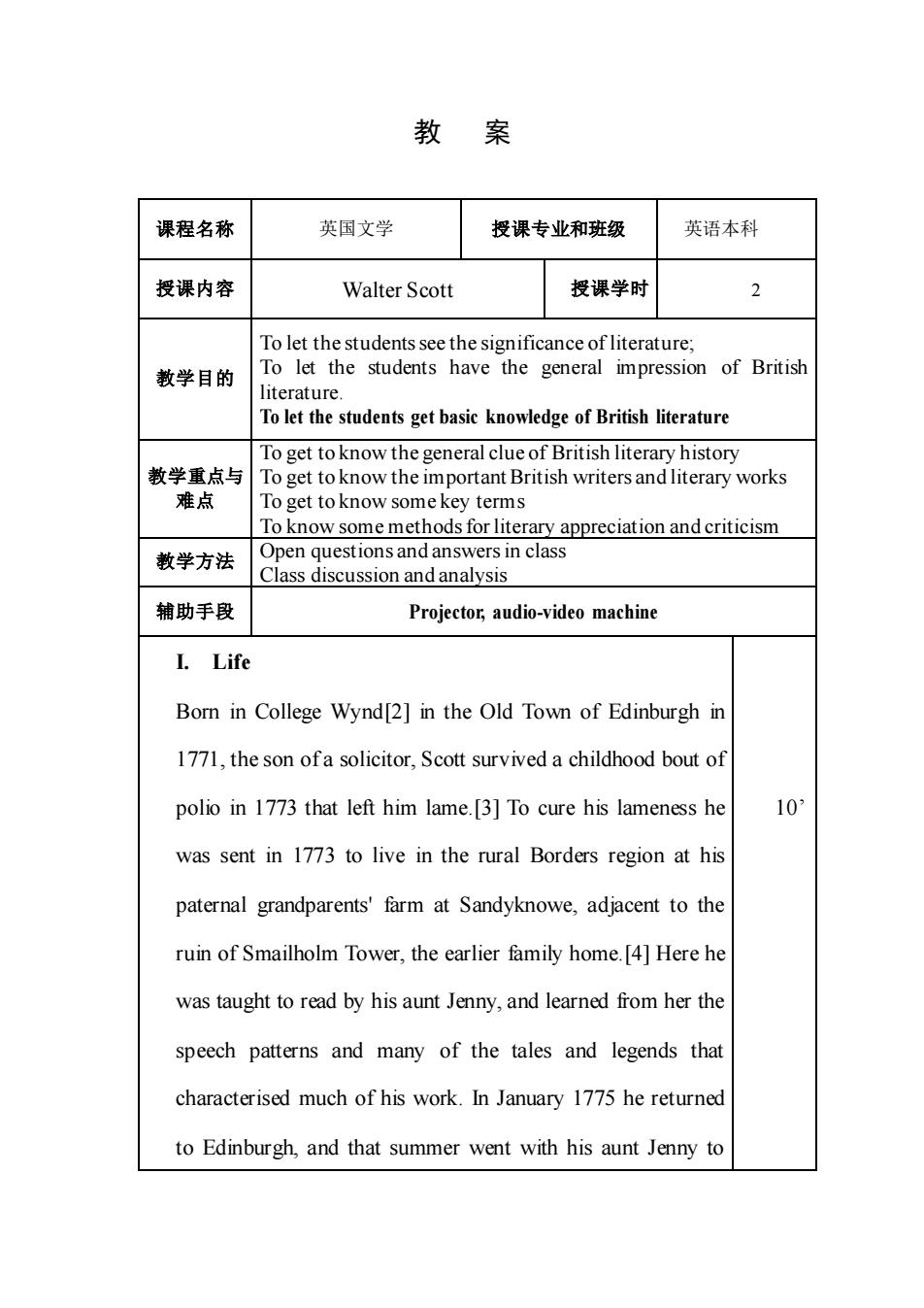
教案 课程名称 英国文学 授课专业和班级 英语本科 授课内容 Walter Scott 授课学时 2 To let the students see the significance of literature; 教学目的 To let the students have the general impression of British literature To let the students get basic knowledge of British literature To get to know the general clue of British literary history 教学重点与To get to know the important British writers and literary works 难点 To get to know some key terms To know some methods for literary appreciation and criticism 教学方法 Open questions and answers in class Class discussion and analysis 辅助手段 Projector audio-video machine I.Life Born in College Wynd[2]in the Old Town of Edinburgh in 1771,the son ofa solicitor,Scott survived a childhood bout of polio in 1773 that left him lame.[3]To cure his lameness he 10 was sent in 1773 to live in the rural Borders region at his paternal grandparents'farm at Sandyknowe,adjacent to the ruin of Smailholm Tower,the earlier family home.[4]Here he was taught to read by his aunt Jenny,and learned from her the speech patterns and many of the tales and legends that characterised much of his work.In January 1775 he returned to Edinburgh,and that summer went with his aunt Jenny to
教 案 课程名称 英国文学 授课专业和班级 英语本科 授课内容 Walter Scott 授课学时 2 教学目的 To let the students see the significance of literature; To let the students have the general impression of British literature. To let the students get basic knowledge of British literature 教学重点与 难点 To get to know the general clue of British literary history To get to know the important British writers and literary works To get to know some key terms To know some methods for literary appreciation and criticism 教学方法 Open questions and answers in class Class discussion and analysis 辅助手段 Projector, audio-video machine I. Life Born in College Wynd[2] in the Old Town of Edinburgh in 1771, the son of a solicitor, Scott survived a childhood bout of polio in 1773 that left him lame.[3] To cure his lameness he was sent in 1773 to live in the rural Borders region at his paternal grandparents' farm at Sandyknowe, adjacent to the ruin of Smailholm Tower, the earlier family home.[4] Here he was taught to read by his aunt Jenny, and learned from her the speech patterns and many of the tales and legends that characterised much of his work. In January 1775 he returned to Edinburgh, and that summer went with his aunt Jenny to 10’
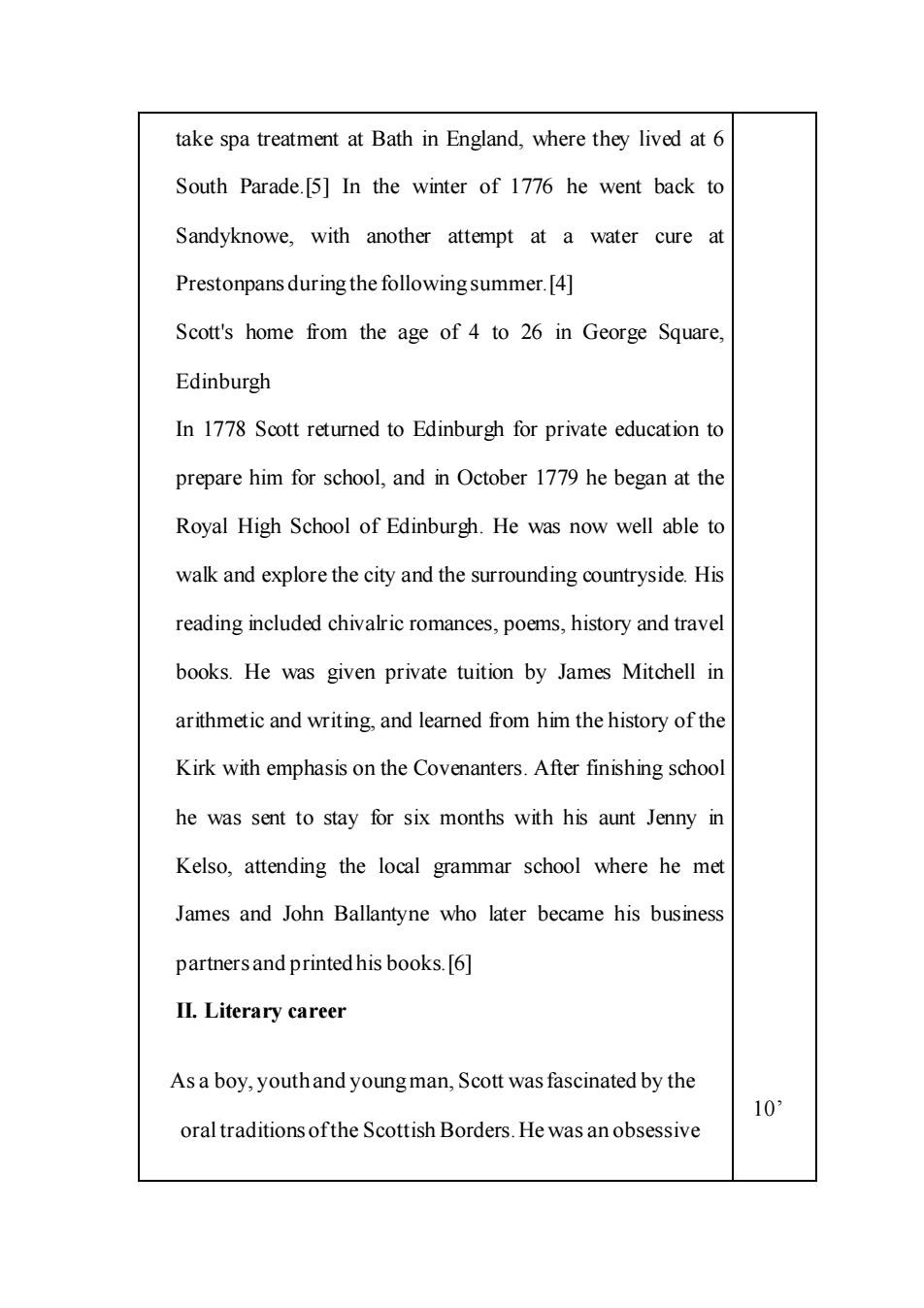
take spa treatment at Bath in England,where they lived at 6 South Parade.[5]In the winter of 1776 he went back to Sandyknowe,with another attempt at a water cure at Prestonpans during the followingsummer.[4] Scott's home from the age of 4 to 26 in George Square, Edinburgh In 1778 Scott returned to Edinburgh for private education to prepare him for school,and in October 1779 he began at the Royal High School of Edinburgh.He was now well able to walk and explore the city and the surrounding countryside.His reading included chivalric romances,poems,history and travel books.He was given private tuition by James Mitchell in arithmetic and writing,and learned from him the history of the Kirk with emphasis on the Covenanters.After finishing school he was sent to stay for six months with his aunt Jenny in Kelso,attending the local grammar school where he met James and John Ballantyne who later became his business partners and printed his books.[6] II.Literary career As a boy,youthand youngman,Scott was fascinated by the 10 oral traditions ofthe Scottish Borders.He was an obsessive
take spa treatment at Bath in England, where they lived at 6 South Parade.[5] In the winter of 1776 he went back to Sandyknowe, with another attempt at a water cure at Prestonpans during the following summer.[4] Scott's home from the age of 4 to 26 in George Square, Edinburgh In 1778 Scott returned to Edinburgh for private education to prepare him for school, and in October 1779 he began at the Royal High School of Edinburgh. He was now well able to walk and explore the city and the surrounding countryside. His reading included chivalric romances, poems, history and travel books. He was given private tuition by James Mitchell in arithmetic and writing, and learned from him the history of the Kirk with emphasis on the Covenanters. After finishing school he was sent to stay for six months with his aunt Jenny in Kelso, attending the local grammar school where he met James and John Ballantyne who later became his business partners and printed his books.[6] II. Literary career As a boy, youth and young man, Scott was fascinated by the oral traditions of the Scottish Borders. He was an obsessive 10’
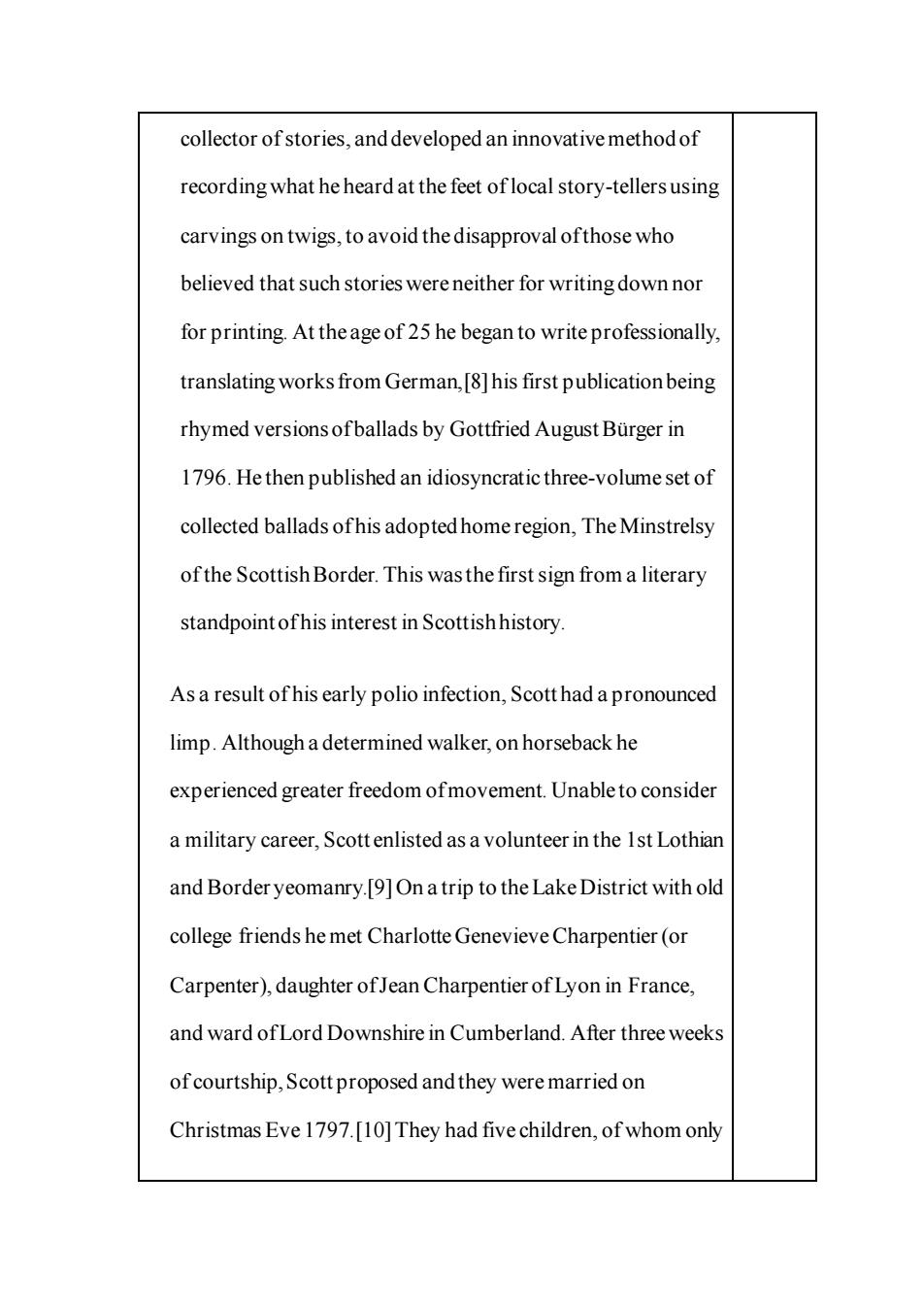
collector of stories,and developed an innovative method of recording what he heard at the feet of local story-tellers using carvings on twigs,to avoid the disapproval ofthose who believed that such stories were neither for writing down nor for printing.At theage of 25 he began to write professionally. translating works from German,[his first publication being rhymed versions ofballads by Gottfried August Burger in 1796.He then published an idiosyncratic three-volume set of collected ballads ofhis adoptedhome region,The Minstrelsy ofthe Scottish Border.This wasthe first sign from a literary standpoint ofhis interest in Scottishhistory. Asa result of his early polio infection,Scott had a pronounced limp.Although a determined walker,on horseback he experienced greater freedom ofmovement.Unable to consider a military career,Scottenlisted as a volunteer in the Ist Lothiar and Border yeomanry.[9]On a trip to the Lake District with old college friends he met Charlotte Genevieve Charpentier(or Carpenter),daughter ofJean Charpentier of Lyon in France, and ward ofLord Downshire in Cumberland.After three weeks of courtship,Scott proposed andthey were married on Christmas Eve 1797.[10]They had five children,of whom only
collector of stories, and developed an innovative method of recording what he heard at the feet of local story-tellers using carvings on twigs, to avoid the disapproval of those who believed that such stories were neither for writing down nor for printing. At the age of 25 he began to write professionally, translating works from German,[8] his first publication being rhymed versions of ballads by Gottfried August Bürger in 1796. He then published an idiosyncratic three-volume set of collected ballads of his adopted home region, The Minstrelsy of the Scottish Border. This was the first sign from a literary standpoint of his interest in Scottish history. As a result of his early polio infection, Scott had a pronounced limp. Although a determined walker, on horseback he experienced greater freedom of movement. Unable to consider a military career, Scott enlisted as a volunteer in the 1st Lothian and Border yeomanry.[9]On a trip to the Lake District with old college friends he met Charlotte Genevieve Charpentier (or Carpenter), daughter of Jean Charpentier of Lyon in France, and ward of Lord Downshire in Cumberland. After three weeks of courtship, Scott proposed and they were married on Christmas Eve 1797.[10]They had five children, of whom only
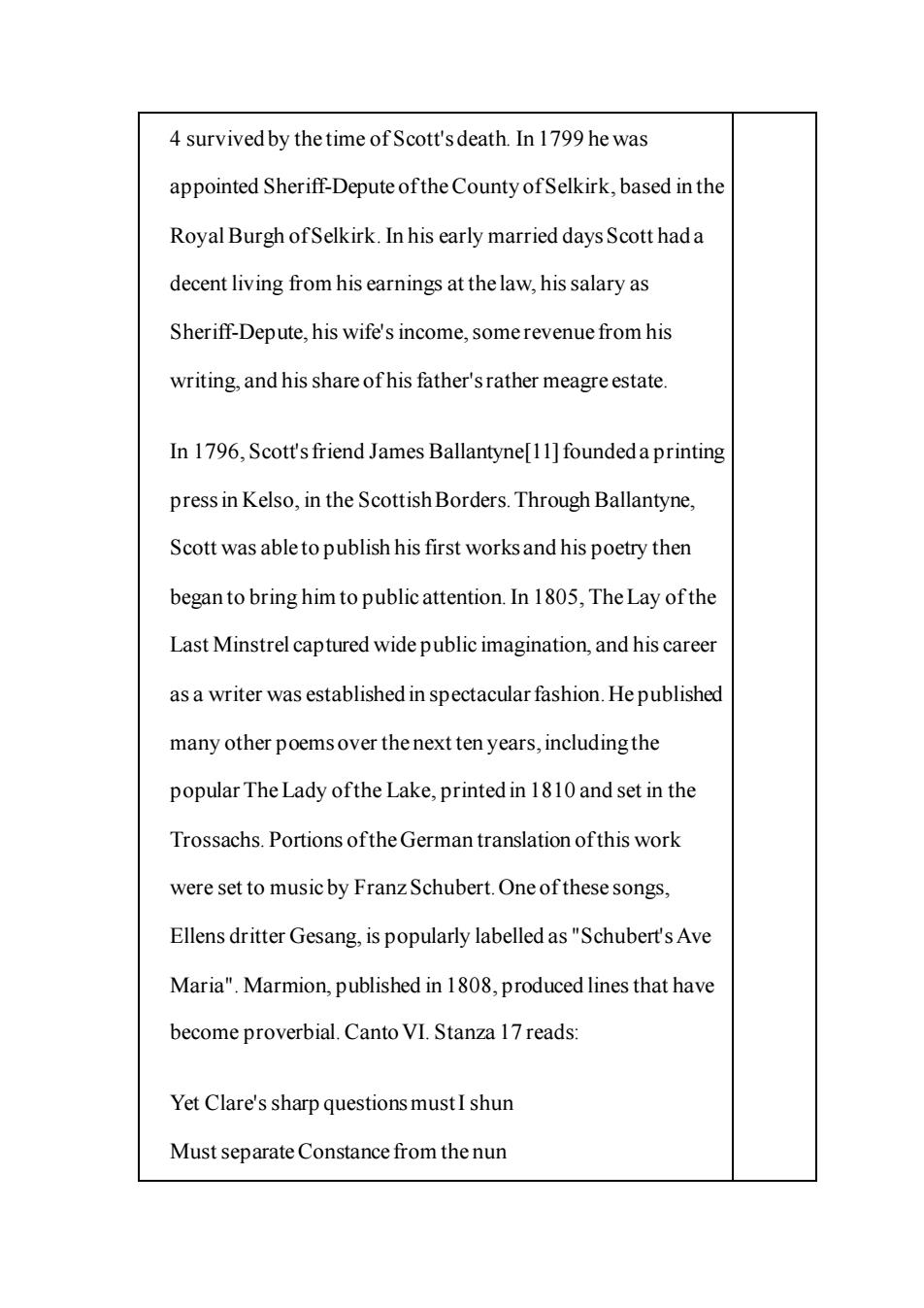
4 survived by the time of Scott's death.In 1799 he was appointed Sheriff-Depute ofthe County ofSelkirk,based in the Royal Burgh ofSelkirk.In his early married days Scott had a decent living from his earnings at the law,his salary as Sheriff-Depute,his wife's income,some revenue from his writing,and his share ofhis father'srather meagreestate. In 1796,Scott's friend James Ballantyne[11]founded a printing press in Kelso,in the Scottish Borders.Through Ballantyne. Scott was able to publish his first worksand his poetry then began to bring him to public attention.In 1805,The Lay of the Last Minstrel captured wide public imagination,and his career as a writer was established in spectacular fashion.He published many other poems over the next ten years,including the popular The Lady ofthe Lake,printedn1810andset nthe Trossachs.Portions ofthe German translation ofthis work were set to music by Franz Schubert.One ofthese songs, Ellens dritter Gesang,is popularly labelled as"Schubert's Ave Maria".Marmion,published in 1808,produced lines that have become proverbial.Canto VI.Stanza 17 reads: Yet Clare's sharp questionsmustI shun Must separate Constance from the nun
4 survived by the time of Scott's death. In 1799 he was appointed Sheriff-Depute of the County of Selkirk, based in the Royal Burgh of Selkirk. In his early married days Scott had a decent living from his earnings at the law, his salary as Sheriff-Depute, his wife's income, some revenue from his writing, and his share of his father's rather meagre estate. In 1796, Scott's friend James Ballantyne[11]founded a printing press in Kelso, in the Scottish Borders. Through Ballantyne, Scott was able to publish his first works and his poetry then began to bring him to public attention. In 1805, The Lay of the Last Minstrel captured wide public imagination, and his career as a writer was established in spectacular fashion. He published many other poems over the next ten years, including the popular The Lady of the Lake, printed in 1810 and set in the Trossachs. Portions of the German translation of this work were set to music by Franz Schubert. One of these songs, Ellens dritter Gesang, is popularly labelled as "Schubert's Ave Maria". Marmion, published in 1808, produced lines that have become proverbial. Canto VI. Stanza 17 reads: Yet Clare's sharp questions must I shun Must separate Constance from the nun
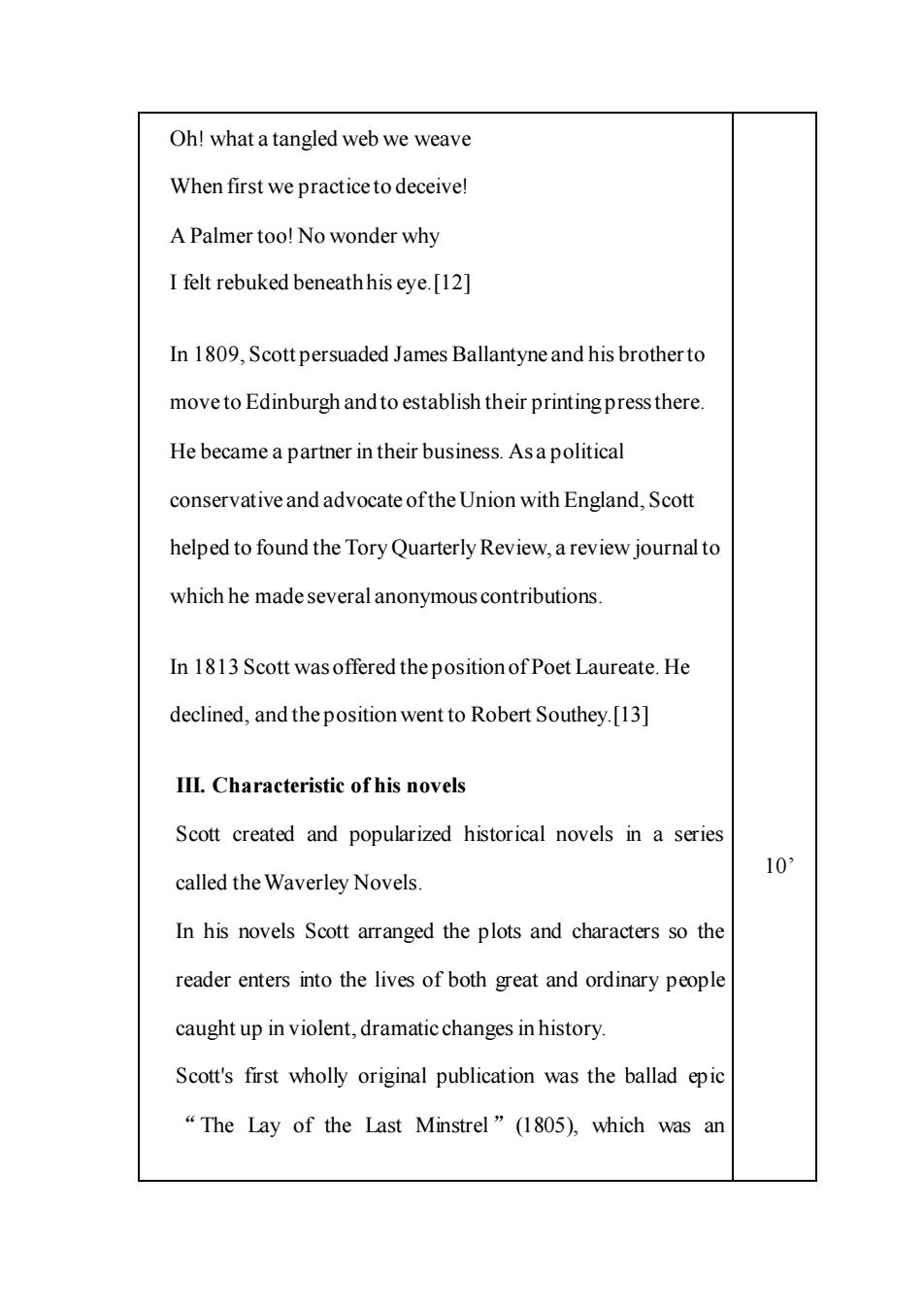
Oh!what a tangled web we weave When first we practice to deceive! A Palmer too!No wonder why I felt rebuked beneathhis eye.[12] In 1809,Scott persuaded James Ballantyne and his brotherto move to Edinburgh and to establish their printing press there. He became a partner in their business.Asa political conservative and advocate ofthe Union with England,Scott helped to found the Tory Quarterly Review,a review journal to which he made several anonymous contributions. In 1813 Scott was offered the position of Poet Laureate.He declined,and the position went to Robert Southey.[13] III.Characteristic of his novels Scott created and popularized historical novels in a series 10 called the Waverley Novels In his novels Scott arranged the plots and characters so the reader enters into the lives of both great and ordinary people caught up in violent,dramatic changes in history. Scott's first wholly original publication was the ballad epic "The Lay of the Last Minstrel"(1805),which was an
Oh! what a tangled web we weave When first we practice to deceive! A Palmer too! No wonder why I felt rebuked beneath his eye.[12] In 1809, Scott persuaded James Ballantyne and his brother to move to Edinburgh and to establish their printing press there. He became a partner in their business. As a political conservative and advocate of the Union with England, Scott helped to found the ToryQuarterly Review, a review journal to which he made several anonymous contributions. In 1813 Scott was offered the position of Poet Laureate. He declined, and the position went to Robert Southey.[13] III. Characteristic of his novels Scott created and popularized historical novels in a series called the Waverley Novels. In his novels Scott arranged the plots and characters so the reader enters into the lives of both great and ordinary people caught up in violent, dramatic changes in history. Scott's first wholly original publication was the ballad epic “The Lay of the Last Minstrel”(1805), which was an 10’